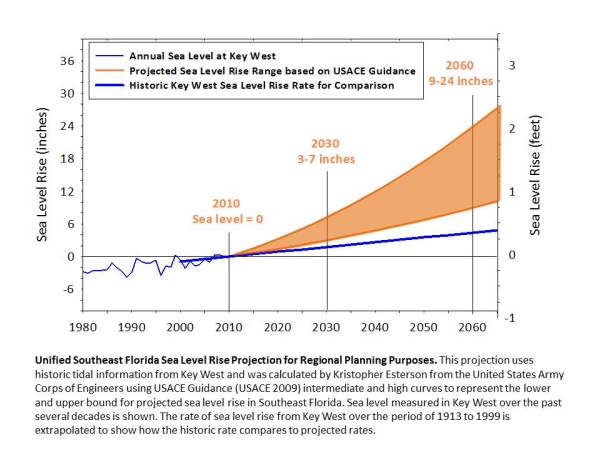For Miami, Sea Level Rise Has Already Gone Exponential
(AP story showing the effects of 9 inches of sea level rise over the last 100 years. What the story doesn’t mention is that half of this sea level rise has occurred within the past 16 years and fully a third of it has occurred within the past 5 years. Video source: Associated Press.)
7
October, 2014
This
week, Miami is scrambling to deal with a flooding emergency.
But
the cause is not the looming approach of a major hurricane or even a
powerful tropical storm. The flood emergency for the coming three
days is simply a seasonal astronomical high tide. Something they are
now calling a King Tide. A condition that arises due to solar and
lunar alignment a few times every year. A gravitational flux that
pushes high tides another foot or so above the normal range.
Decades
or even years ago, astronomical high tide wasn’t so much of a
problem for Miami. Now, it means flooded roads and runways. It means
salt water backing up through city drainage and municipal water
systems. It means sea walls over-topped. It means lawns, properties
and businesses covered in water.
The
crisis is so serious that the city has already allocated more than
400 million dollars to deal with the problem. And this week, crews
and flood prevention planners are scrambling to face the rising seas.
Rapidly
Rising Waters
(Peak high tide trend from 1998 through 2014 shows sea levels rose by 4.3 inches over the past 16 years with most of the rise occurring since 2008. Image source: Dr. Zhaohua Wu, FSU)
At
issue is the fact that Miami is facing a climate change driven sea
level rise that is in the process of going exponential. A ramping
rate of water rise that is being driven by a combination of glacial
melt, ocean expansion due to warming, a backing up of the Gulf Stream
which is raising waters all along the Eastern Seaboard, and a
continuation of land subsistence in South Florida due to a variety of
factors.
From
1914 through 1998, sea levels rose by an average of 0.06 inches per
year — a rate that was barely noticeable to residents and city
planners alike. But from 1998 to 2009 the pace increased to a more
troubling 0.14 inches per year. And from 2009 to the present year the
pace again jumped to a terrifying 0.67 inches per year.
An
exponential rate of sea level rise that, in the past year alone,
raised Miami’s surrounding ocean waters by 0.86 inches. Should the
observed sea level rise over recent years continue, Miami will be
facing 6-9 feet of additional water by the end of this century and
not the 3-4 feet currently predicted.
Vulnerable
Miami, South Florida
Miami
is particularly vulnerable to such rapid rates of sea level rise for
a couple of reasons. First, most of Miami is less than four feet
above 20th Century sea levels. So even moderate rates of sea level
rise put major portions of the city under water. Second, the city
sits on porous limestone. The rock, riddled with holes, leaks like a
sieve. So building sea walls won’t help Miami much as water will
simply rise up through the rocks themselves.
Because
Miami is so low-lying and surrounded on almost all sides by water, it
is often seen as one of the most vulnerable cities to human-driven
climate change. However, the geological conditions are not unique to
Miami and remain a problem for almost all Florida cities. The porous
limestone is a feature of the entire Florida Peninsula. So the
problems Miami is facing now will become problems for hundreds of
cities and communities up the coast and in more central regions of
the state as well.
At
most immediate risk is all of South Flordia. Miami-Dade and Broward
Counties have about half of their residents living below the 4 foot
above sea level line. Collier and Monroe counties also boast very
large populations within just 4 feet of already rapidly rising seas.
Such a rise would generate inland water upwelling throughout much of
south Florida and the Everglades even as many coastal regions faced
inundation. Small, low-lying islands and barrier zones would be
swallowed by the sea or broken by incursions through weak points. The
mangroves, already in retreat, would be swiftly beaten back. Inland
lakes, invaded by higher pressure salt water from below, would also
rise.
(Sea level rise observations and projections through 2060 for Key West. Note that observations end at 2009 and that the tidal gauges have recorded a 3 inch sea level rise from 2009 through 2014 for Miami — already hitting the bottom range of expected sea level rise by 2030. Image source: Southeast Florida Regional Climate Change Compact Page.)
As
an example, seasonal high tides are already having an effect on the
Delray Beach region that is starkly similar to problems now plainly
visible in Miami. In the historic Marina neighborhood, water bubbles
up from storm drains and spills over the banks of the Intracoastal
Waterway into streets.
Charle
Dortch, a resident for 17 years said in a recent interview with
the Sun
Sentinel:
“It’s
progressively getting worse. The water is coming up the roadway right
into people’s front yards. It’s flooding the parking area. It’s
coming up higher and higher every year.”
Links:
(Hat
Tip to TodaysGuestIs)





No comments:
Post a Comment
Note: only a member of this blog may post a comment.